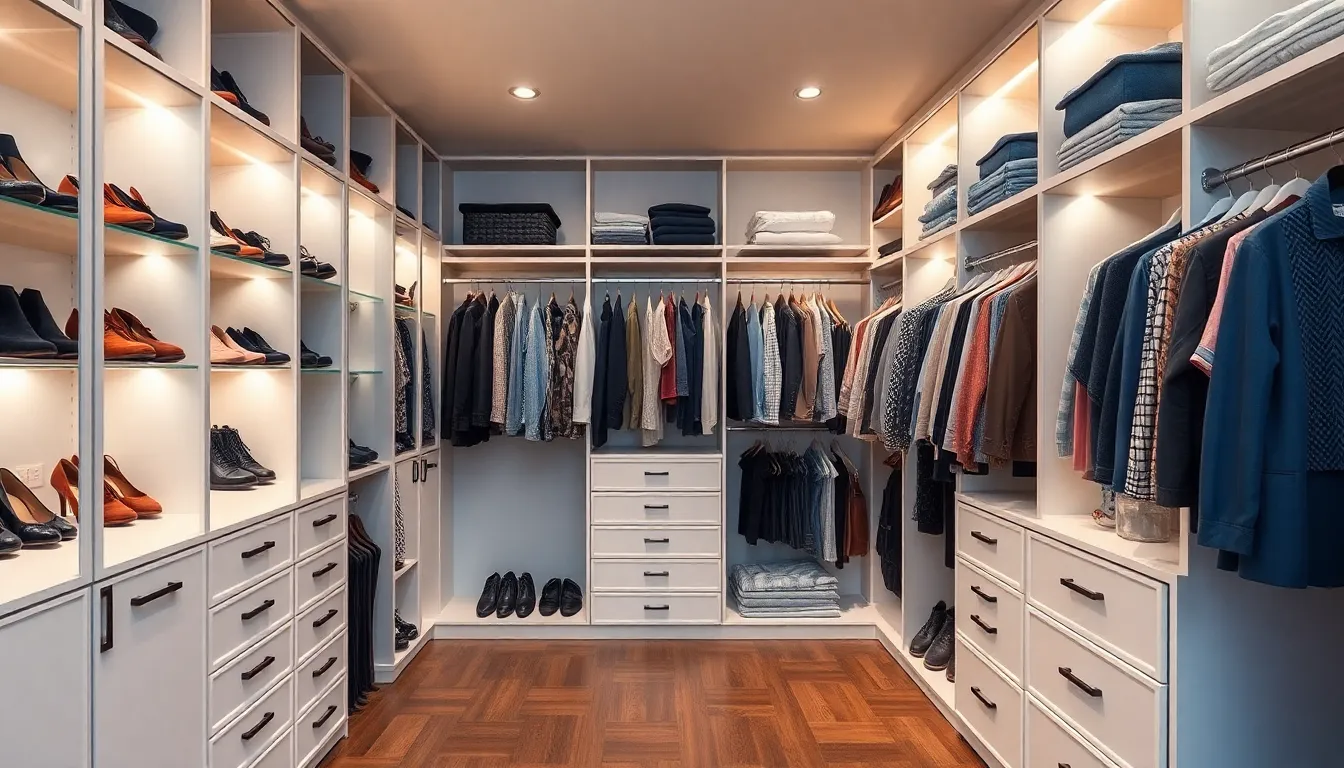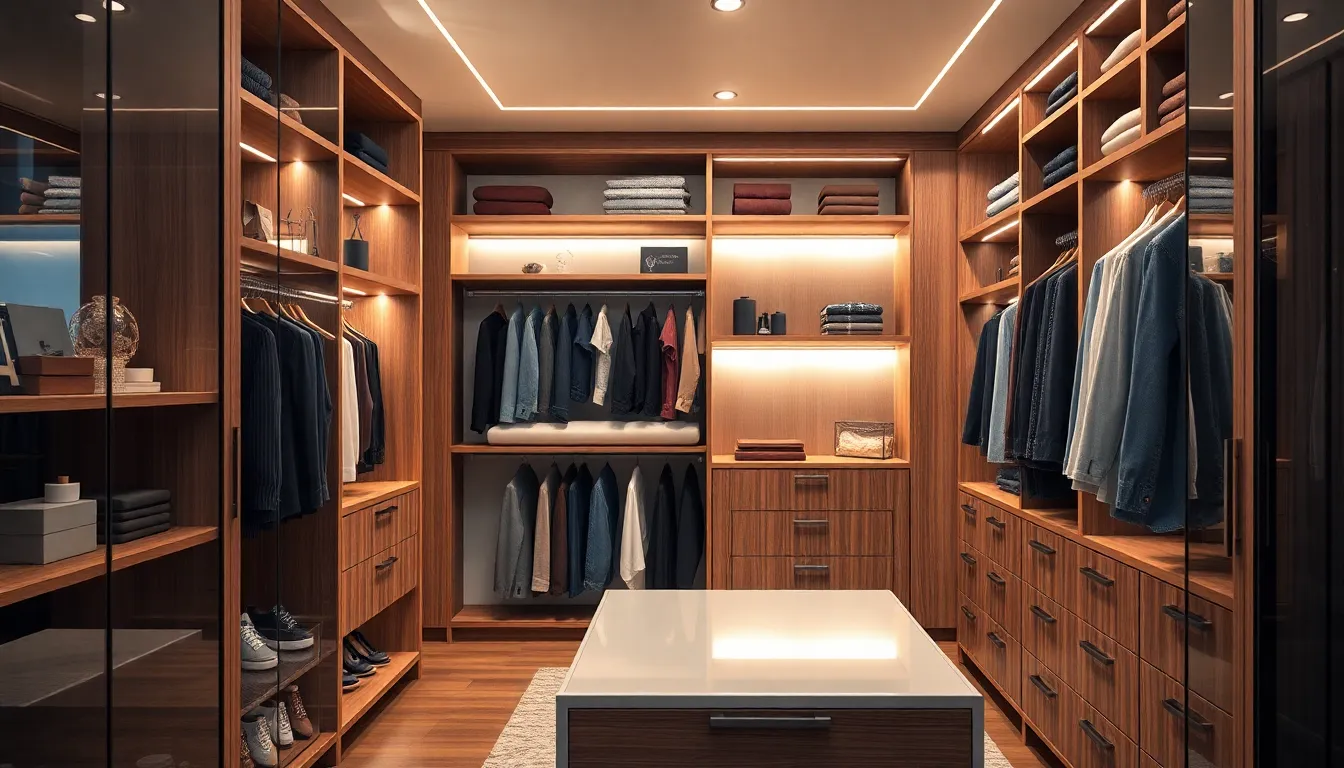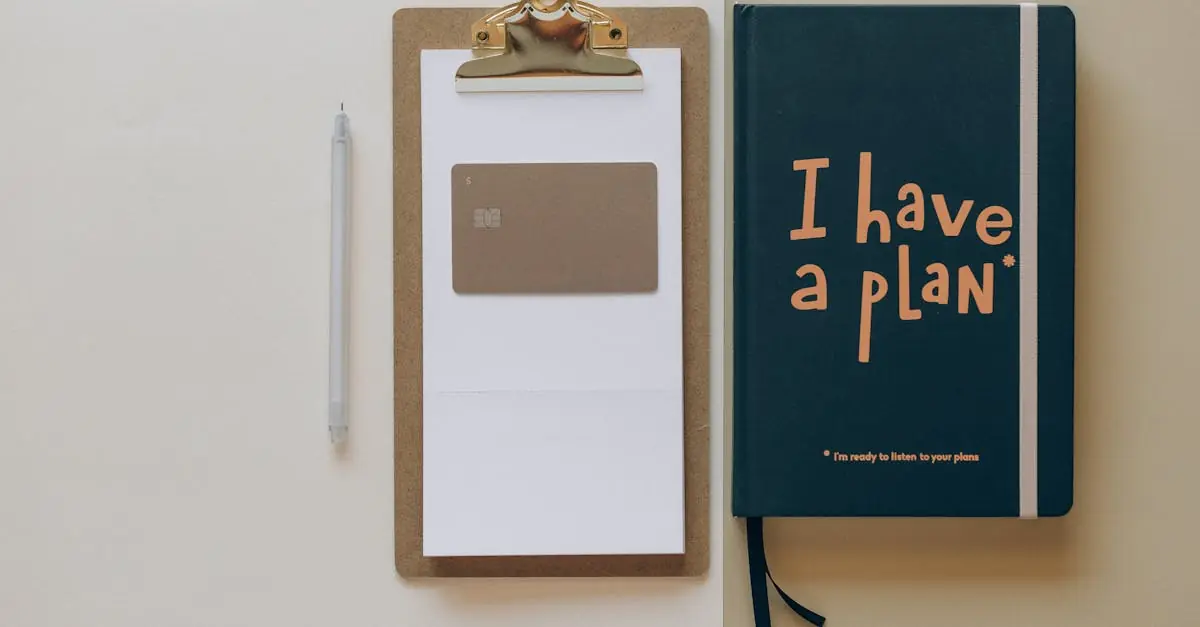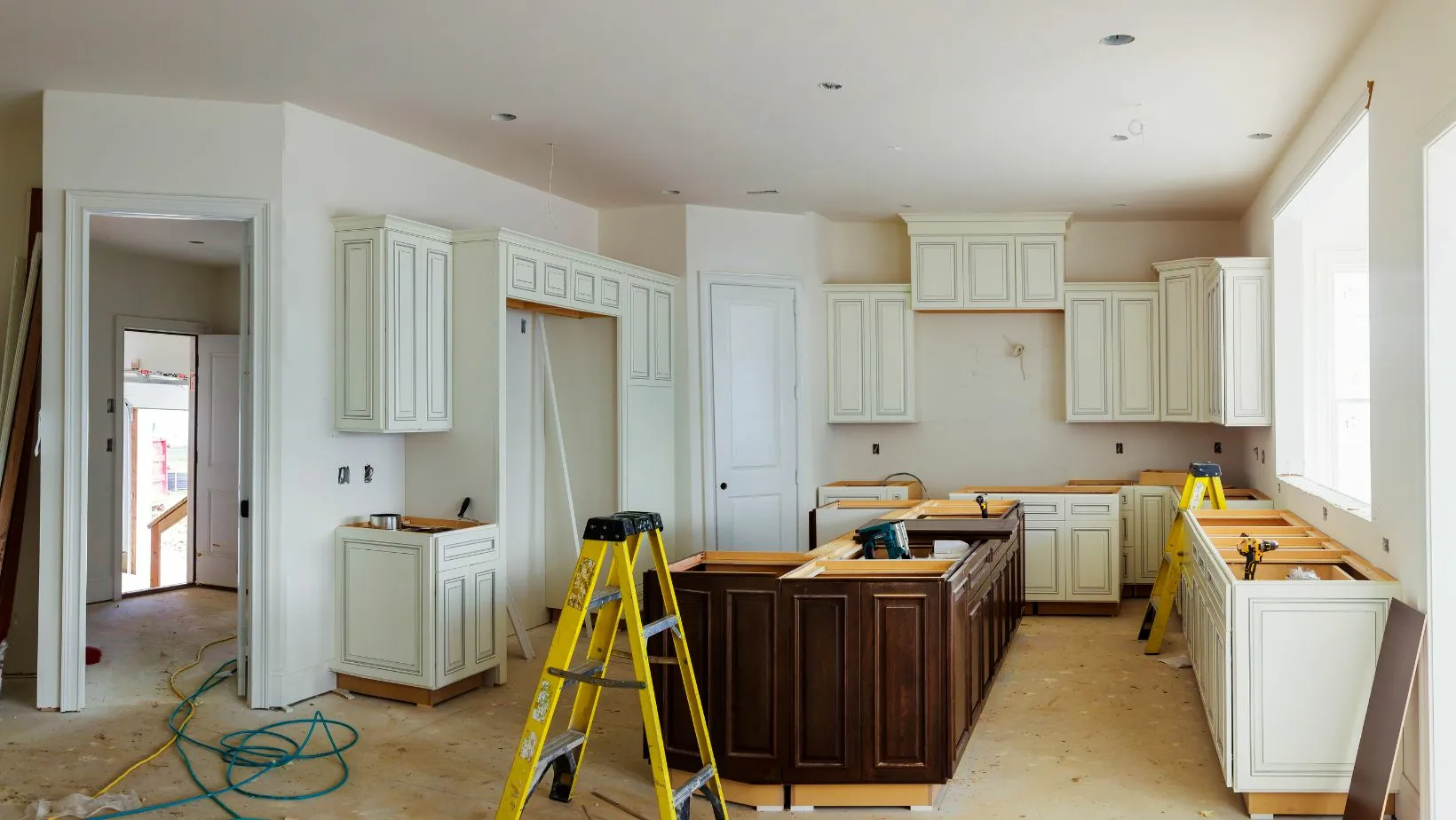A well-designed walk-in closet can transform any home, offering both functionality and style. As homeowners seek to maximize their space, the allure of a personalized closet becomes increasingly appealing. It’s not just about storage; it’s about creating a sanctuary for organization and fashion.
Constructing a walk-in closet requires careful planning and creativity. From choosing the right layout to selecting materials, each decision impacts the final result. Whether it’s a luxurious retreat or a practical solution for everyday use, understanding the essential elements of walk-in closet construction can make all the difference. With the right guidance, anyone can turn their vision into reality, enhancing their living space and lifestyle.
Table of Contents
ToggleOverview of Walk-In Closet Construction
Walk-in closet construction involves careful planning, selection of materials, and an understanding of spatial dynamics. Effective design optimizes available space while enhancing functionality and aesthetics.
Designing the Layout
Designing the layout requires a practical approach. Homeowners should assess their storage needs first. Space allocation for hanging clothes, shelving, and accessories is crucial. Many designs incorporate islands for additional storage or seating, maximizing every available square foot.
Choosing Materials
Choosing materials affects both durability and style. Common options include wood, laminate, and wire shelving. Wood provides a classic look but often incurs higher costs, while laminate offers affordability and versatility. Wire shelving promotes airflow, making it suitable for various climates.
Lighting
Lighting plays a significant role in walk-in closet construction. Proper illumination highlights clothing and accessories, enhancing visibility. LED lighting serves as an energy-efficient option that also adds a modern touch. Ambient lighting combined with task lighting creates an inviting atmosphere.
HVAC Considerations
HVAC considerations ensure comfort within the walk-in closet. Proper ventilation prevents moisture build-up, protecting items from damage. For larger spaces, climate control solutions, such as dedicated vents or small air conditioning units, maintain a stable environment.
Installation Process
The installation process typically follows a structured approach. Firstly, it requires accurate measurements to determine the exact layout. Secondly, assembly of units occurs, followed by the installation of shelves, rods, and other features. The final step includes organizing belongings to maximize efficiency and maintain a clutter-free space.
Budgeting
Budgeting remains an essential aspect of walk-in closet construction. Costs depend on size, material choices, and custom features. Planning a budget ensures homeowners set realistic expectations without overspending, allowing for customizations that genuinely reflect personal style and needs.
Benefits of a Walk-In Closet

Walk-in closets offer significant advantages for homeowners, enhancing both functionality and aesthetics. These personalized spaces can transform storage challenges into organized solutions.
Increased Storage Space
Increased storage space stands as one of the primary benefits of a walk-in closet. Walk-in closets provide ample square footage compared to traditional reach-in closets. This additional space accommodates various storage solutions, such as:
- Shelving units for shoes and accessories
- Hanging rods optimized for different clothing lengths
- Drawers for folded garments and miscellaneous items
Effective use of vertical space allows for maximum storage capacity. Homeowners gain the ability to store seasonal items efficiently, minimizing clutter throughout their living area. Ultimately, the tailored design of a walk-in closet supports diverse storage needs and simplifies everyday routines.
Enhanced Organization
Enhanced organization plays a vital role in the appeal of walk-in closets. Personalized layouts promote clarity and accessibility, making it easy to locate items quickly. Key organizational features include:
- Designated zones for different types of clothing, such as formal attire, casual wear, and outerwear
- Built-in organizers and accessories, like jewelry trays and belt racks, that keep items neatly arranged
- Clear labeling systems for bins and drawers, streamlining retrieval processes
These well-planned spaces reduce the time spent searching for clothing or accessories and foster a seamless dressing experience. Well-crafted organization also contributes to maintaining the overall aesthetic of the bedroom.
Essential Design Considerations
Designing an efficient walk-in closet involves critical considerations that enhance both its functionality and aesthetic appeal. Two primary factors to address include layout and materials.
Layout and Space Planning
Effective layout and space planning is foundational for a walk-in closet. Assess the overall dimensions to maximize storage potential. Incorporate features such as:
- Hanging rods: Install adjustable rods at varying heights for dresses, shirts, and pants.
- Shelving units: Utilize wall space with open shelves and closed cabinetry for versatile storage.
- Islands: Integrate an island for additional storage and workspace if space allows.
Utilize triangular and linear arrangements for optimal flow and accessibility. Ensure adequate clearance between sections, typically at least 36 inches, to facilitate movement and retrieval of items.
Materials and Finishes
Choosing the right materials and finishes impacts both durability and visual appeal. Commonly used materials include:
- Wood: Offers a classic look and can support heavier items, making it ideal for cabinetry and shelving.
- Laminate: Provides a range of colors and finishes at a lower cost, suitable for a modern aesthetic.
- Wire shelving: Increases ventilation and visibility, perfect for lighter garments and accessories.
Select finishes that complement the overall design theme. Consider high-quality hardware, such as handles and hinges, to enhance functionality. Also, incorporate paint or wallpaper that harmonizes with the closet’s lighting, ensuring a bright and inviting space.
Steps for Constructing a Walk-In Closet
Constructing a walk-in closet requires careful preparation and a clear understanding of the installation process. Below are essential steps to guide the construction.
Planning and Measuring
Planning starts with assessing space and functionality needs. Homeowners should measure the available area, noting dimensions and identifying potential obstacles, like doors and windows. Creating a rough sketch helps visualize the layout and determine the best arrangement for shelving, hanging rods, and storage units. It’s crucial to consider traffic flow, ensuring movement within the closet remains unobstructed. Establishing a list of storage items also aids in defining design specifics, including required shelving height and depth. Prioritizing personalized storage solutions enhances usability and ensures the closet meets individual preferences.
Installation Process
The installation process consists of several sequential steps. Accurate measurements lead to cutting materials precisely. Starting with the frame, it’s vital to secure shelving brackets and rods according to the planned layout. Using quality hardware ensures stability. Walls benefit from reinforcement to support heavy items. Lighting installation comes next, with LED fixtures providing optimal visibility and energy efficiency. Finalizing the closet involves organizing belongings, using dividers and labels to maintain organization. Consistent check-ins with the design plan during installation ensure alignment with the initial vision, resulting in a customized and functional walk-in closet.
Cost Factors in Walk-In Closet Construction
Understanding the cost factors in walk-in closet construction involves a detailed look at materials and labor expenses. These elements play a crucial role in determining the overall budget.
Budgeting for Materials
Material choices significantly influence the total cost of a walk-in closet. Common materials include:
- Wood: A durable option, wood provides strength and aesthetic appeal, typically ranging from $1,000 to $3,000, depending on the type and quality.
- Laminate: Offering a cost-effective alternative, laminate costs generally range from $600 to $1,500, depending on the finish and design.
- Wire Shelving: The least expensive option, wire shelving is ideal for budget-conscious projects, averaging between $200 and $600.
Homeowners must consider factors such as style and durability when selecting materials. Opting for high-quality materials ensures longevity and enhances the closet’s overall visual appeal.
Labor Costs
Labor costs vary based on complexity and regional rates. Key considerations include:
- Installation: Hiring a professional generally ranges between $500 to $2,000, depending on the project’s scope and labor market in the area.
- Customization: Custom designs may incur additional costs with experienced contractors, potentially increasing labor fees by 20% or more.
- DIY vs Professional: DIY projects can save on labor costs but may require initial investment in tools and materials.
Understanding these labor cost dynamics helps homeowners set realistic budgets and make informed decisions for their walk-in closet construction projects.
A well-constructed walk-in closet not only elevates the functionality of a home but also enhances its overall aesthetic. By prioritizing thoughtful planning and material selection, homeowners can create a personalized space that meets their storage needs while reflecting their unique style.
Incorporating efficient layouts and effective organization techniques can streamline daily routines and reduce clutter. With careful consideration of budget and installation processes, anyone can transform their closet into a beautiful and practical retreat. Ultimately, a walk-in closet serves as a testament to both creativity and functionality, making it a valuable addition to any home.







